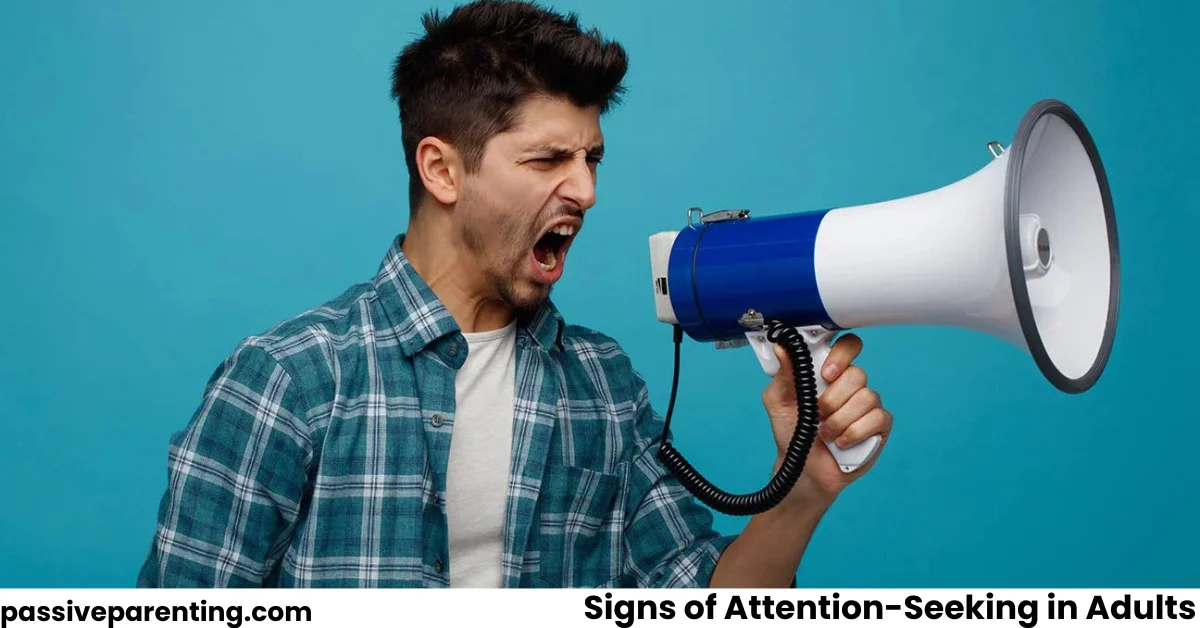Everyone enjoys feeling seen, valued, and appreciated. It’s a natural human need. However, when this desire becomes excessive or constant, it can turn into attention-seeking behavior. Understanding the signs of attention-seeking in adults is essential, not just for recognizing it in others but also for identifying it within ourselves.
While it’s often associated with children or teenagers, adults can also display these behaviors in subtle or dramatic ways. They might seek validation through constant praise, emotional manipulation, or even social media. Learning to identify these signs helps promote healthier communication, stronger boundaries, and better emotional balance.
This article explores what attention-seeking behavior looks like in adults, the psychological reasons behind it, and how to manage it with empathy and awareness.
What Is Attention-Seeking Behavior?
Attention-seeking behavior is a pattern of actions intended to draw others’ focus or approval. In adults, it may not always be obvious. Some people openly crave validation, while others seek it through subtle emotional cues or exaggerated reactions.
The signs of attention-seeking in adults often stem from emotional insecurity, loneliness, or an unmet need for affirmation. For example, someone who feels unnoticed at work or unappreciated in relationships might unconsciously act out to gain recognition.
It’s important to note that attention-seeking doesn’t always come from arrogance or vanity. Often, it’s a coping mechanism, a way to fill an emotional void.
Common Signs of Attention-Seeking in Adults
Attention-seeking behaviors can appear in many forms. Some are obvious, while others are hidden behind charm, humor, or vulnerability. Recognizing these signs can help you understand what’s really going on beneath the surface.
1. Constant Need for Validation
One of the most recognizable signs of attention-seeking in adults is a relentless desire for praise and reassurance. These individuals may frequently ask questions like “Did I do okay?” or fish for compliments after completing simple tasks. Their self-worth often depends on external validation rather than inner confidence.
2. Exaggerating Success or Struggles
Attention-seeking adults might amplify stories whether about achievements or hardships to gain admiration or sympathy. They often use emotional storytelling to remain the center of focus, sometimes stretching the truth to make an impression.
3. Dominating Conversations
In social settings, attention-seeking individuals often steer discussions back to themselves. Even when others share personal experiences, they may interrupt or one-up the story to regain attention. Over time, this behavior can make conversations feel one-sided and emotionally draining.
4. Creating Drama or Conflict
Some people unconsciously use conflict to attract attention. They may stir drama, overreact to minor issues, or play the victim to ensure others focus on them. Drama often replaces healthy communication as a way to feel significant.
5. Oversharing Personal Details
While openness can build connection, constant oversharing especially about deeply private or inappropriate topics can signal a deeper need for validation or sympathy. Adults who overshare often crave emotional responses from others to feel valued.
6. Social Media Dependence
In today’s digital age, attention-seeking has found a new outlet: social media. Some adults post excessively, seek constant feedback through likes and comments, or share exaggerated emotions online. This virtual validation becomes addictive and reinforces attention-seeking cycles.
7. Playing the Victim
Another common behavior involves consistently portraying oneself as misunderstood, mistreated, or unlucky. This approach draws empathy but can also manipulate others into providing constant reassurance or support.
8. Flirtatious or Competitive Behavior
Adults may seek validation through charm or competition. They might flirt to gain attention or compete unnecessarily to prove their worth. This behavior often stems from insecurity and fear of being overlooked.
Why Adults Engage in Attention-Seeking Behavior
The signs of attention-seeking in adults don’t appear randomly. They usually stem from deeper psychological or emotional causes that shape how individuals relate to others.
1. Low Self-Esteem
Many attention-seeking behaviors begin with insecurity. Adults with low self-esteem depend on external praise to feel valuable. Compliments temporarily boost their confidence, but the effect fades quickly, leading to a repetitive need for more attention.
2. Childhood Neglect or Emotional Deprivation
Adults who lacked attention or affirmation during childhood may grow up constantly seeking it from others. Their emotional foundation was built on inconsistency, leaving them craving validation as adults.
3. Fear of Rejection or Abandonment
People who fear being forgotten or unloved might overcompensate by demanding attention. This fear pushes them to act in ways that ensure they remain in others’ thoughts, even if through conflict or drama.
4. Personality Traits or Disorders
Certain personality types, such as those with narcissistic or histrionic tendencies, naturally seek admiration or emotional reactions. However, not everyone who seeks attention has a disorder, these behaviors can exist on a spectrum.
5. Social Media Influence
Platforms built on likes, comments, and followers encourage attention-seeking. Adults who rely heavily on online validation may unconsciously tie their self-worth to digital approval.
Emotional Impact of Attention-Seeking in Adults
Attention-seeking behavior affects both the person displaying it and those around them.
For the individual, it often leads to emotional exhaustion. The constant need for validation becomes a mental burden, leaving little room for genuine self-acceptance. Over time, it can cause anxiety, frustration, and even resentment when others don’t respond as expected.
For friends, family, or coworkers, the behavior can feel draining. Relationships may become unbalanced, with one person always giving reassurance and the other taking it. This imbalance can create distance and frustration, ultimately damaging connection.
Understanding these emotional effects is key to breaking the cycle. Compassion helps, but boundaries are just as important.
Healthy vs. Unhealthy Attention-Seeking
It’s crucial to recognize that not all attention-seeking is bad. Humans naturally crave attention and recognition, it’s part of social bonding. However, the difference lies in intent and balance.
Healthy attention-seeking happens when someone shares achievements or emotions in a genuine way, without manipulation. It builds connection and confidence.
Unhealthy attention-seeking, on the other hand, is rooted in insecurity. It often involves exaggeration, guilt-tripping, or self-promotion to gain approval.
Understanding this distinction allows you to respond with empathy while maintaining emotional boundaries.
How to Handle Attention-Seeking Adults
If you frequently interact with someone showing the signs of attention-seeking in adults, it’s important to manage the relationship calmly and thoughtfully.
1. Set Boundaries
Be kind but firm. Avoid indulging exaggerated stories or dramatic reactions. Instead, focus on calm, fact-based communication that discourages manipulation.
2. Acknowledge Genuine Effort
When attention-seeking stems from insecurity, genuine validation can help. Praise real accomplishments and positive behavior while ignoring attempts at drama.
3. Stay Grounded During Emotional Episodes
If someone overreacts or creates conflict for attention, avoid escalating. Respond calmly and redirect the conversation toward resolution instead of emotion.
4. Model Healthy Behavior
Show what balanced attention looks like. Give and receive appreciation naturally, without making it transactional. Over time, this can teach the other person emotional stability.
5. Suggest Self-Reflection
Encourage self-awareness. Sometimes, a simple conversation about how behavior affects relationships can help someone recognize and change their patterns.
Recognizing Attention-Seeking Tendencies in Yourself
Sometimes, the signs of attention-seeking in adults appear within ourselves. Everyone has moments of wanting reassurance or praise, that’s human. But if this becomes constant or emotionally draining, self-reflection can help.
Start by asking:
- Do I feel anxious when I’m not noticed?
- Do I often exaggerate my experiences?
- Do I rely on others’ praise to feel good about myself?
If the answer is yes, it’s not a failure, it’s an opportunity for growth. Building self-esteem, pursuing fulfilling hobbies, and surrounding yourself with supportive people can help you feel validated from within.
Practices such as journaling, mindfulness, or therapy can also strengthen emotional independence. Over time, you’ll rely less on others’ approval and more on your own self-worth.
The Role of Social Media in Attention-Seeking
Social media amplifies the human desire for attention. The cycle of posting, liking, and commenting can create a feedback loop where people measure self-worth through online validation.
Adults may post frequently about personal achievements, emotions, or struggles to gain recognition. While sharing can be healthy, overuse often reinforces dependence on external approval.
To maintain balance, limit screen time, post authentically, and focus on real-life relationships. Validation that comes from genuine human connection is far more sustaining than online approval.
When Attention-Seeking Becomes Harmful
Attention-seeking becomes harmful when it starts to negatively affect relationships, career, or self-esteem. If someone’s behavior leads to repeated conflicts, loneliness, or emotional distress, it may be time to seek help.
Therapy can be valuable in these cases. Professionals can help uncover root causes such as trauma, insecurity, or fear of abandonment, and teach emotional regulation strategies. Recognizing the problem is the first step toward healing.
How to Replace Attention-Seeking with Healthy Behaviors
Breaking free from unhealthy attention-seeking begins with self-awareness. Start by focusing on actions that build genuine confidence instead of temporary validation.
- Develop personal goals unrelated to others’ opinions.
- Celebrate private wins rather than public praise.
- Practice gratitude for who you are, not just what you achieve.
- Strengthen emotional connections through listening and empathy.
Over time, self-assurance grows from within, reducing the need to constantly seek approval.
Conclusion
Recognizing the signs of attention-seeking in adults helps create healthier relationships and stronger self-awareness. While everyone craves recognition at times, excessive or manipulative behavior often signals deeper emotional needs.
The goal isn’t to judge but to understand, whether you see these traits in others or yourself. Attention-seeking often masks a longing for acceptance, belonging, or love. By addressing these underlying needs, adults can learn to build confidence rooted in self-worth rather than external approval.
In the end, true attention comes naturally when authenticity replaces performance. The more secure we feel within ourselves, the less we need validation from others and the healthier our connections become.




